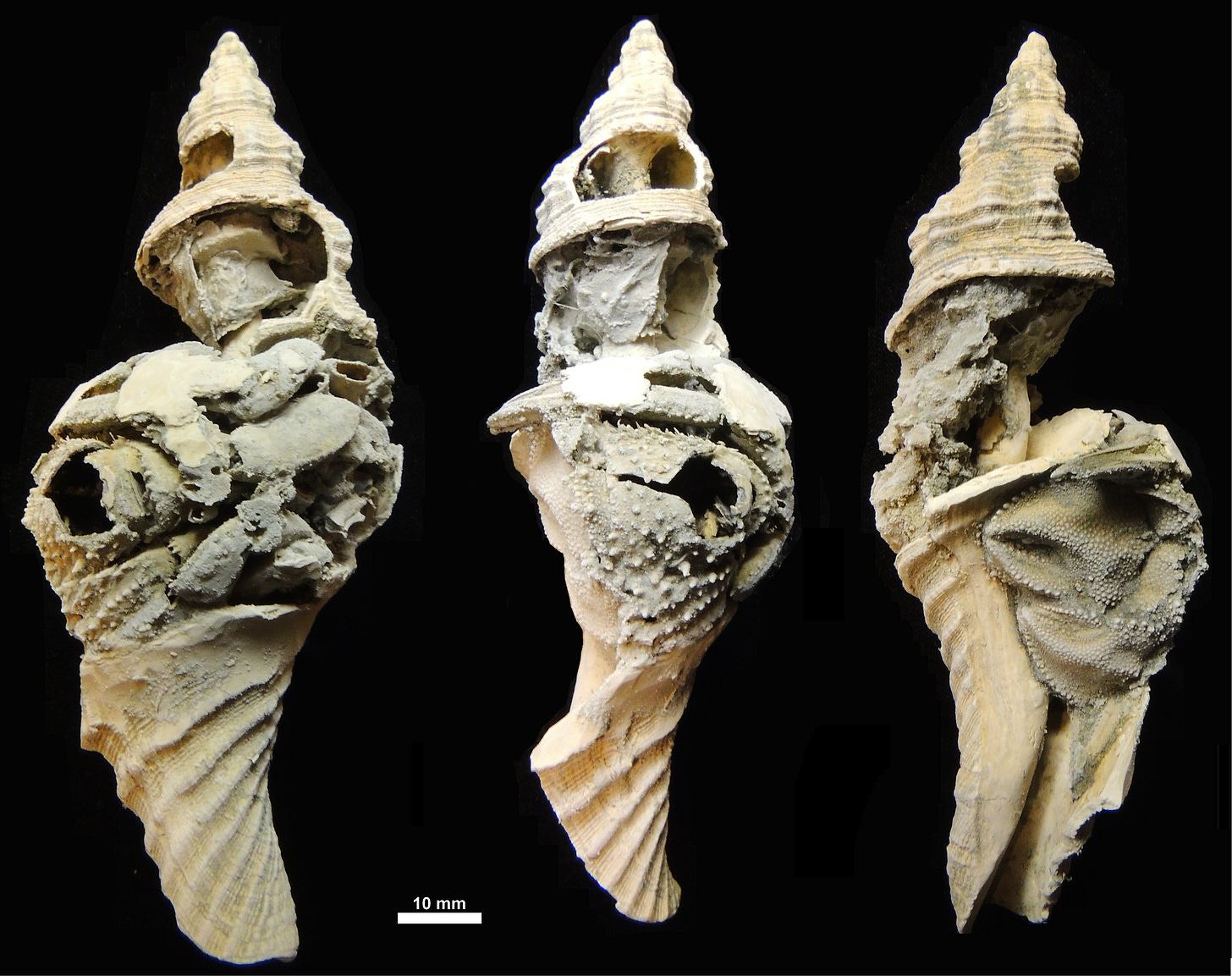The Calvert Cliffs are located on the western shore of the Chesapeake Bay in Maryland. They are one of the most fossil-rich Miocene-age deposits on North America’s Atlantic coast and a hot spot for collecting shark teeth, whale and dolphin bones, and shells of both snails and bivalves. The youngest of three formations at the cliffs is the St. Marys. It represents the Neogene period that lasted from the end of the Paleogene, about 23 million years ago, until the beginning of Quaternary, about two and one-half million years ago.
Pagurus hazenorum is one of two recently discovered species of extinct hermit crabs from the formation. Hermit crabs include about 800 species of the superfamily Paguroidea. They occupy empty shells of molluscs to protect their vulnerable, non-calcified, elongate and spiraled abdomen. Most species use snail shells, although some occupy bivalves or even hollow pieces of wood. As the crab grows, it engages in a crab’s version of the Goldy Locks tale, looking for a shell that is not too small, not too large, but just right.
Several species have been observed to create what is known as a vacancy chain. Trying on an empty shell and finding it too large, a crab returns to its original shell and waits near the vacant one. As other shell-seeker arrives, it too tries on the empty one for size. Eventually there may be a line of up to twenty crabs. When a crab finally arrives for which the empty shell is the right fit, its old one is seized by a waiting crab, whose vacated shell is claimed by the next in line, and so on.
The specific epithet, hazenorum, ends in -orum, telling me that it is named in honor of a couple. In this case, Dr. Robert Hazen of the Carnegie Institution for Science and his wife, Margaret, a writer and historian. So far, the new species is known from a single specimen that is interestingly still inside the gastropod shell that it last occupied. Such occurrences of fossil crabs in their shells are relatively rare. The earliest cases involve ammonite shells from the lower Jurassic of Germany, upper Jurassic of Russia, and lower Cretaceous of Yorkshire, England. It is thought that most crabs become dislodged post mortem, explaining their rarity.
Holotype of Pagurus hazenorum from upper Miocene, St. Marys Formation, in cliff south of Little Cover Point, Calvert County, Maryland, USA, preserved inside its host shell. Left to right: ventral, dorso-ventral, and ventral aspects. Photo courtesy of Dr. J. J. W. Wallaard.
It was during the early Cretaceous that hermit crabs shifted from using ammonite conchs to gastropod shells. This switch is reflected in crab morphology, too. With a notable change from elongated body forms, well-suited to plug ammonite apertures, to more rounded forms, better proportioned for gastropod shells. In the case of the new species, the crab is damaged — the carapace is missing, perhaps a casualty along with visible damage to the host shell — but enough characters survive to confidently place it in the genus Pagurus and determine that it is not among known species.
The new crab resembles three previously known species: one from the west coast of Florida, one from New Zealand, and a third, the common European hermit crab. The latter living species, Pagurus bernhardus, inhabits the Atlantic coastline of Europe, in both sand- and rock-bottom shorelines. It’s found from arctic waters to as far south as Portugal.
Recent molecular studies indicate that the genus Pagurus is artificial. That is, species grouped together in the genus are not each others’ nearest relatives. Instead of common ancestry, similarity of appearance is the basis for the genus. Their resemblance may be due to both convergent evolution and certain epigenetic factors. It has been demonstrated, for example, that the shape of the host shell influences the shape of claws, called chelipeds, that are important for species identification.
Chelipeds are the conspicuous claws that hermit crabs use to grasp and pinch and are commonly preserved in fossil beds, while the carapace is only rarely recovered. In life, the larger left claw is used for defense and to seal off the opening of the shell that the crab has occupied. The smaller, right claw is used in feeding.
The other new species is Paguristes timoni and is named after the hermit, misanthrope, and tragic title character of Shakespeare’s ‘Timon of Athens.’
With its over-sized, imposing left claw, one might think the crab would be outgoing and aggressive, but some, like Pagurus hazenorum, even after millions of years, have never come out of their shells.
Further Reading
Wallaard, J.J. W., Fraaije, R.H.B., Bakel, B.W.M., Nance, J.R., Lindholm, A. and J.W.M. Jagt (2023) New hermit crab species (Anomura, Paguroidea) from the upper Miocene St. Marys formation of Maryland (USA), preserved in their host shells. Zootaxa 5227: 389-397.




